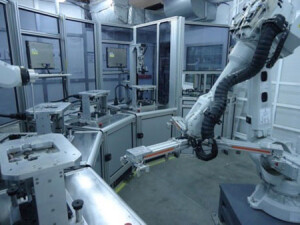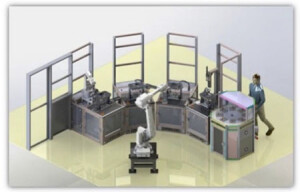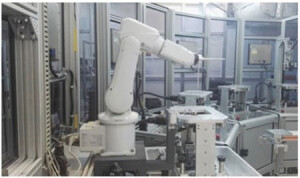Automation of a production cell through CompactRIO and robotics
 Sagemcom, a European leader in telecommunications and energy, has been steadily growing since becoming a PRIME alliance member for sponsoring smart meters with PLC-based communication for energy meters and smart grids. To increase its production volume at its Tunisa factory, the company looked to implement an automated test bench solution.
Sagemcom, a European leader in telecommunications and energy, has been steadily growing since becoming a PRIME alliance member for sponsoring smart meters with PLC-based communication for energy meters and smart grids. To increase its production volume at its Tunisa factory, the company looked to implement an automated test bench solution.
Four tests are carried out: a vision inspection on a product’s LCD display; a high-potential test (HIPOT ); a power line communication test (PLC); and a functional test. During the vision inspection, the functionality of the LCD and indicating LED of the product are confirmed. In the past, operators performed tests through manual inspection, but more recently Sagemcom automated this through PC-based automatic test benches using Vision Builder for Automated Inspection.
In the HIPOT test, 3.2 KV is injected into a product to check its immunity to this high voltage. The interface with the accommodating instrumentation is through RS232, with a precise time frame for the leakage current’s measurement. The purpose of the PLC test is to simulate the behaviour of the product after field deployment while communicating with the data concentrator in the power line protocol.
The functional testing involves acquiring and analysing communication signals, and then interacting with a product’s button while acting with a cylinder. This test is quite sensitive due to the accuracy needed to interact with some buttons that have limited access.
Duplicating this architecture does not ensure contractual first pass yield (FPY) engagement due to the troubles observed with PC-based solutions (crashes, application bugs, and virus vulnerability). In addition, a budgetary improvement request has been introduced to limit investment on development budget and global solution costs. Considering all these criteria, Sagemcom faced a challenge, and turned to thinking of a constructive way to:
- Enhance FPY and robustness of test benches
- Reduce development time and save money
- Reduce test time and increase volume to save on our investment
- Reduce handling time to provide a better throughput and avoid operator-related delays
- Add technical value to the project (hiring a more qualified support team, taking our company from a pure manufacturer to special machine developer, and maintaining our manufacturing capabilities)
Reducing handling time and providing better throughput
 After considering the challenge, the first step was to determine an efficient way to reduce handling time and deliver better accuracy while positioning products into test fixtures. Simulations concluded that a robotic cell configuration with a central robot for handling products and an additional smaller robot for performing functional test would work well.
After considering the challenge, the first step was to determine an efficient way to reduce handling time and deliver better accuracy while positioning products into test fixtures. Simulations concluded that a robotic cell configuration with a central robot for handling products and an additional smaller robot for performing functional test would work well.
Four test benches were interconnected and synchronised to ensure optimal process flow. Even though the robots were selected for better handling time, Sagemcom faced an additional challenge: finding the best way to program them for an efficient predictive algorithm and setting priority to robot handling.
The objective to reduce test time without neglecting robustness significantly impacts this challenge. The key was to identify the most suitable hardware architecture that can provide the highest level of robustness for each cell’s node. In fact, the project income was to guarantee that the adopted architecture could permit safe data exchange between each node in a way that the product could be functionally tested and inspected through vision.
Sagecom also needed to provide a necessary algorithm to set the priority for positioning the robot arms while communicating through DeviceNet protocol and supervising all safety sensors to prevent any security violation. A control platform was needed that could:
- Ensure vision processing
- Ensure parallel processing operations and advanced programming capability
- Support industrial protocols
- Exchange process information as safely as possible
After analysing the available solutions for machine control, Sagemcom focused on two possible compliant architectures: either using programmable logic controller platforms or the CompactRIO system from NI. The company chose CompactRIO because of the calculation power of its processor and FPGA, its support of a large number of industrial protocols, and its easy interoperability through LabVIEW programming.
 The CompactRIO platform offers built-in vision capabilities and supports camera connectivity over USB and Gigabit Ethernet, which are key differentiators. This system leads to a fully integrated solution and we can save money by avoiding costly smart camera solutions coupled to programmable logic controllers. The CompactRIO platform can also accelerate embedded vision applications through the Vision Development Module, which includes many image processing functions that can run on both a real-time processor and an FPGA.
The CompactRIO platform offers built-in vision capabilities and supports camera connectivity over USB and Gigabit Ethernet, which are key differentiators. This system leads to a fully integrated solution and we can save money by avoiding costly smart camera solutions coupled to programmable logic controllers. The CompactRIO platform can also accelerate embedded vision applications through the Vision Development Module, which includes many image processing functions that can run on both a real-time processor and an FPGA.
The possibility of using CompactRIO to perform true parallel operation through its FPGA offered a way to reduce test time by paralyzing acquisitions and test sequence.
Sagemcom adopted the cRIO-9030 for the project due to its powerful dual-core Intel Atom E3825, its high-value Kintex-7 FPGA, and the possibility of handling an embedded user interface through its MiniDisplay port, which could help save investment by using additional PCs for deporting HMI.
Reduced development time and reduced investment
While confident that LabVIEW would suit this project, there was an initial fear that the migration and upgrade of actual source code from the PC would take additional development time and resources. However, due to the inherent scalability of LabVIEW, some 70 percent of the code was able to be reused when changing the hardware platform from PC to CompactRIO, with minimal coding effort. This saved a significant amount of development time and cost.
In addition, the large set of control and mathematics libraries available in LabVIEW provided great support for developing the predictive algorithm to evaluate robot positioning. LabVIEW also offered support for industrial communication protocols for robotic interfacing like DeviceNet with the release of NI-Industrial Communications for DeviceNet 15, which saved many man hours.
Due to the high interoperability of the CompactRIO system and the native support for true parallelism and precise time looping through FPGA, Sagemcom reduced test time by 21 seconds, which led to 17 percent productivity growth. This represents a higher throughput and a significant return on investment. The company also reduced the number of controllers by using one cRIO-9030 for all test benches instead of a single industrial PC for each machine. This saved 50 percent on controller cost.
Visit the National Instruments website for more information
See all stories for National Instruments
















